Review of Water Vision, by Mirko Zanni
Mirko Zanni is a Swiss-born photographer who’s been diving since 1989. Though he was always interested in photography, it was some time before Zanni began shooting underwater. Despite his relative late start, in 2006, his book Water Vision was awarded the coveted International Prize for Book of Underwater Images at the 33rd World Festival of Underwater Pictures in Antibes. Joining the ranks of Tony Wu and William Tan (2001), and Andrea and Antonella Ferrari (2004), Zanni is one of only a handful of people to have achieved this recognition. Clearly, therefore, you’d expect Water Vision to be good. In my opinion, Water Vision isn’t all that good. Rather, it’s phenomenal.
Absolutely phenomenal.
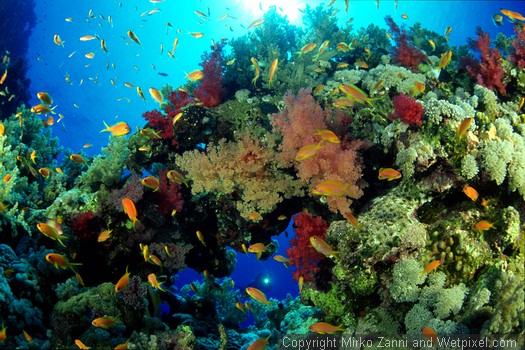
Culled from thousands of shots, Water Vision features what Zanni believes are his 225 best images. Those images breathe life into his epic, beautiful, 256-page coffee-table book. Sprinkled with just enough text to remind you that it is, in fact, a book—but not too many words to get in the way—Zanni and co-author Licia Paris provide brief introductions to each of the book’s nine chapters and identify all the animals featured therein by their Latin as well as their common name, both in Italian and in English.
The book opens with Acque dolci, a homage to Fresh water. Having learned to dive in the chilly, fresh waters of Southern Switzerland, Zanni lovingly pays tribute to where it all began: the Verzasca River. Immediately, readers will marvel at the images’ bold colors, unusual patterns, and fascinating interplay of warbling light and rippling water. Clinically perfect but warm and inviting, Zanni’s river images look like the lithographs of M.C. Escher. Featuring swirling tessellations and curlicued striations, the images almost appear to be optical illusions. Wait—where did that fish just come from? Where is that diver going? They’re not illusions, though: these images are really that glorious.
In my opinion, this is what sets Water Vision apart from other books of underwater images: Zanni’s penchant for patterns. Immediately noticeable, his love of patterns transforms each otherwise beautiful image into a complete work of art. Though many of his subjects are common, the way Zanni shoots them is not.
Studying the stupendous shots, readers will be intrigued by the undulating riverbed, the color of a wrinkled old elephant hide, from which a hulking, curving granite fist emerges, like a giant Mobius strip erupting from the sediment. Featuring odd striations caused by crystal twinning, the fractaled floor of the Verzasca looks like a mutant washboard, folded, bent, wrung out, melting, and abandoned. But it’s not just ancient wrinkled rocks that inform Zanni’s work. It’s the patterns throughout the images that fill the shots and give them life. With his gift for intermingling recognizable shapes with impossible geometric distortions, Zanni’s artistic sensibility would delight Escher. And they’ll delight you, too.
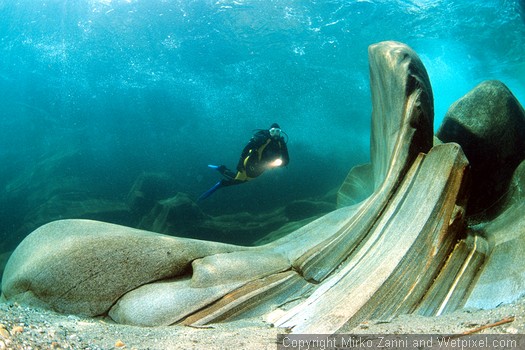
In Fresh water, Zanni also showcases Southern Switzerland’s Sassolo Lake. Taking advantage of the Lake’s unmistakable resource—bizarrely-shapen ice caps—Zanni’s unusual love of pattern peeks through again. In one shot, the ice looks like cotton balls. In another, it’s soap suds. In a third, the ice looks like, well, like ice. Therein lies Zanni’s mastery: three photos. One subject. Three completely different experiences. It’s amazing that Zanni mixes together only hydrogen, oxygen, and a perfectly-placed sunburst. From that simple recipe: diverse, resplendent beauty.
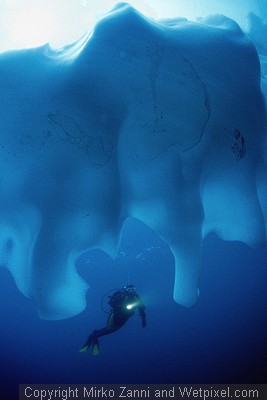
In his shots of Florida rivers—especially those featuring manatees—his passion for patterns is truly unleashed. Like he’s overlaid the sea cows and river beds with a gentle latticework of light, Zanni manages to take an otherwise mundane seascape and render it sublime. Letting the rippling surface of the water act simultaneously as prism and strobe, the sandy floor of Rainbow Spring, for example, pops with drama, warmth, and sensuality. Much like the first time you saw Escher’s Relativity, the opening chapter of Water Vision makes you hunger for more.
Chapter 2, Blue, showcases creatures found in the cerulean pelagic zones—from whale sharks, to turtles; from solitary silvertips, to schooling snapper. Not relying on the patterns produced by sunlight and erosion in Chapter 1, Zanni lets the fish’s intrinsic patterns quietly speak for themselves. Their inherent spottles, shells, and scales—as well as the shapes their schools form—is enough for Zanni.
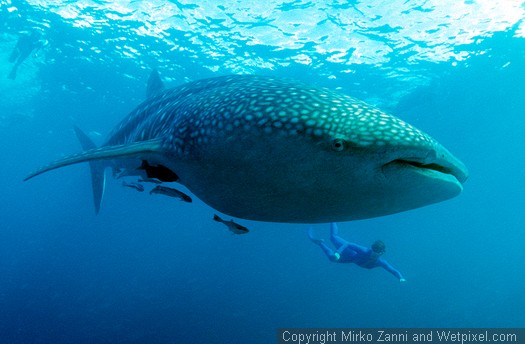
Similarly, in Chapter 3, Neptune’s Gardens, Zanni explores the patterns of reefscapes. From fiery forests of slender Whip corals; to portraits of dappled, delicate soft corals; to a stunning, textured Elephant-ear sponge, Zanni reveals even more patterns elemental in nature.
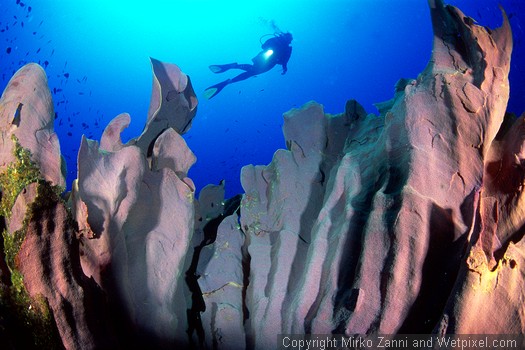
Chapter 4, Sunken Deserts, continues with this theme, granting a starring role to Indonesia’s infinitely-patterned Spottled and Speckled shrimpgobies, Saddleback anemonefish, and Eschmeyer’s scorpion fish (a subtle, pun-y tribute to the math-loving artist that keeps creeping into Zanni’s work? Coincidence, I’m sure…)
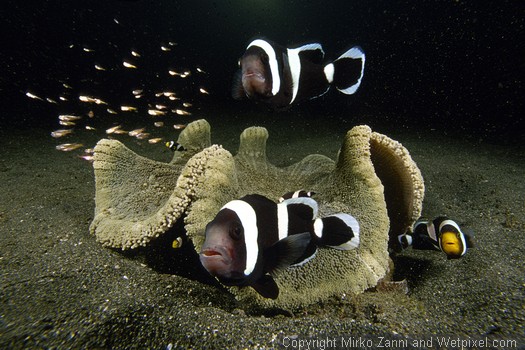
Chapter 5, Portraits, opens with the most terrifying shot ever taken. This feral Stargazer—pockmarked, with teeth like broken rakes, and suffering from a terrible case of divergent strabismus—invokes crippling, primordial, flesh-melting fear. That the fish is the palest shade of pink imaginable makes the image all the more jarring. Zanni then takes the reader through a Rogue’s Gallery of Scorpion fish, Painted frogfish, Bluestriped fangblennies, Silverlined mudskippers, and on. Each is stunning. In subsequent chapters—Microcosms, Living Together, and Relics of the Sea—Zanni escorts readers into the worlds of macro fishes, commensal living, and sunken ships. So many different kinds of images emerge from these pages, that it’s hard to choose a favorite. Is it his treatment of Starfish shrimps, which shows every color in the spectrum? What about the mysterious Venn diagram-like Greenthraot Parrotfish eye, with its multi-colored concentric circles? That shot of “Kate” in PNG is, literally, the picture of grace.
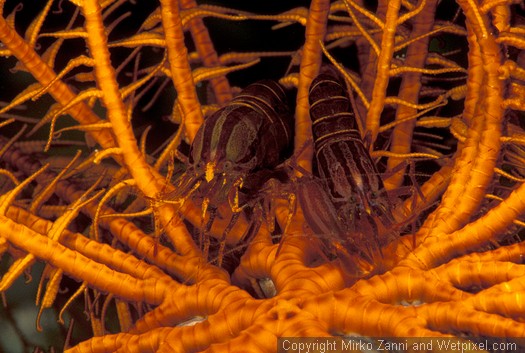
Except for possibly Acque dolci, Chapter 8, Mimicry, is my favorite. Featuring—you guessed it!—pages upon pages of eye-popping patterns, flipping through this chapter is like touring a wallpaper store on acid. Speckles, spots, and stripes litter this chapter—and all the images sparkle with stunning colors.
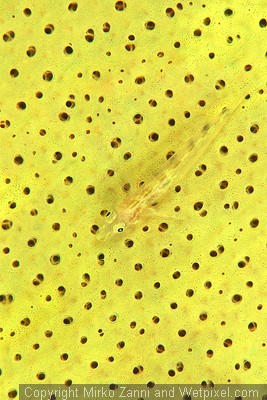
The open-mouthed Painted frogfish waiting for dinner was my favorite…until I found the Pygmy seahorse image. International orange, clinging to a portion of a polyhedron, waiting, calm, patient. At once, the image invokes isolation, humor, drama, and warmth. I love it. It’s my favorite photo in the book.
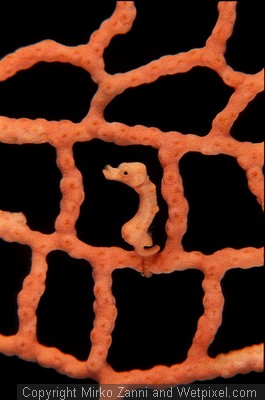
In Water Vision, Zanni demonstrates that his playfulness and artistic sensibility are unmatched by most shooters. If you’re a studious shooter, though, you can learn heaps from Zanni. Composition, lighting, and angle are the least of the gifts Zanni can give you. Aim higher. Aim for an entirely new perspective.
If you want to see some of Zanni’s handiwork, check out Water Vision’s website. If you want a copy of Water Vision, the price is €59, plus S&H. The “Limited Edition Hard Box” (a signed, collector’s edition) is €69, plus S&H. If you’re interested in either, contact Zanni directly at .(JavaScript must be enabled to view this email address).